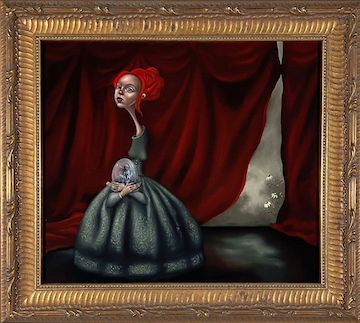What’s in a Name? A Closer Look at Thea
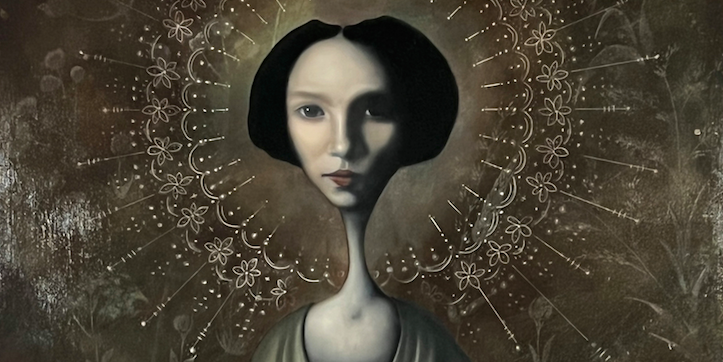
What Comes First?
Ah, the age-old question: What came first, the title or the painting? For every artist and every piece of art, I'm sure the answer is different. For me, it changes almost every time too, unless I'm working on a series like my "Nocturnes"—a collection of ambient and minimal landscapes.
When I approach a blank canvas, one of two things is usually true. Either I have a crystal-clear idea of what I'm painting, down to the meaning of every element, or I just go with the flow, letting the forces of inspiration do the heavy lifting. The muses never explicitly share their thoughts, so sometimes I'm left to wonder about a painting's meaning myself. Of course, the truth is never so black and white; each painting is a combination of these two scenarios. No matter how well-defined an image is in my mind, once I'm at the easel, the painting takes on a life of its own, and those pesky forces have their fun if they feel the need.
I'm reminded of the quote by Salvador Dalí: "If you understand your painting beforehand, you might as well not paint it." And while I see the merit in this, I also enjoy having a bit of a roadmap, especially for my more elaborate portraits. But once the painting is finished, that’s when the real fun begins: the interpretation. It's not uncommon for me to find new and deeper meaning in my work after the varnish has dried, the frame is on, and it finally hangs under a proper light. It's only then—when the final piece stands miles away from that initial thought or doodle—that it takes its first breath. And it's at this point that some of my works are truly christened. That was exactly the case for my portrait, which I named Thea.

Title: Thea
Available HERE
First Thoughts
I knew many things about this painting before I applied the first brushstrokes. For instance, I knew she would represent divinity, as she'd have a halo of some sort. I also knew she'd be one of my more signature works, with an elongated neck that plays with the idea of the spiritual and worldly natures within all of us. This duality would be expressed more fully through a color scheme rich in greens. Green has a particularly dualistic meaning in classical art: it can represent nature, birth, and even eternal life, but it also symbolizes death, the darker side of nature, and jealousy or envy—think William Shakespeare coining the term "green with envy."
It was only then, as I delved into the process, that the forces threw me an idea: why not make a subtle nod to this duality and the play on beauty and death by adorning our would-be saint with a medallion over her heart? What if it were a gold relief of Medusa's head? Sure, why not? And why not place her head within a multi-petaled flower while you're at it? Okay, okay, muses, I get it.
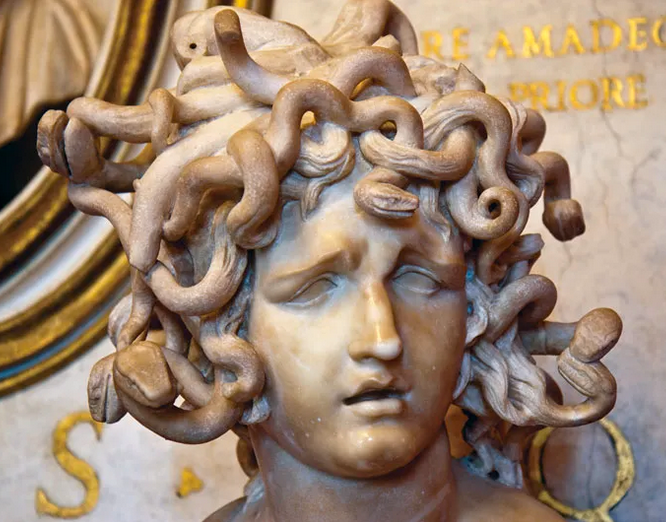
Medusa, marble sculpture by Gian Lorenzo Bernini, 1630;
in the Capitoline Museums, Rome.
Thus, a medallion of Medusa emerged over her heart. This, in itself, has symbolic significance, as the heart chakra is considered the bridge between our spiritual and worldly natures. The color associated with this chakra is, wouldn't you know it, green, and it's represented by a multi-petaled lotus flower. Medusa herself is a poignant representation of beauty and ugliness, as well as the transformative power of a victim reclaiming their power—even if it makes them monstrous. In ancient Greece, her head was even used as an amulet to ward off evil and avert malevolent forces. I can’t help but think of the Versace brand and its use of the symbol.
Mother of God
The painting was complete, and it was time to give her a name. I knew she was powerful, a personification of divinity. And that's when the muses gave me the name Thea, from Theia, which literally means "goddess" or "divine." That worked.
As one of the twelve Titans, Theia was the goddess of sight and shimmering light. Along with her brother Hyperion (times were different back then), she gave birth to the sun, the moon, and the dawn—Helios, Selene, and Eos. It was believed that she was the goddess who endowed gold, silver, and gems with their brilliance and value.
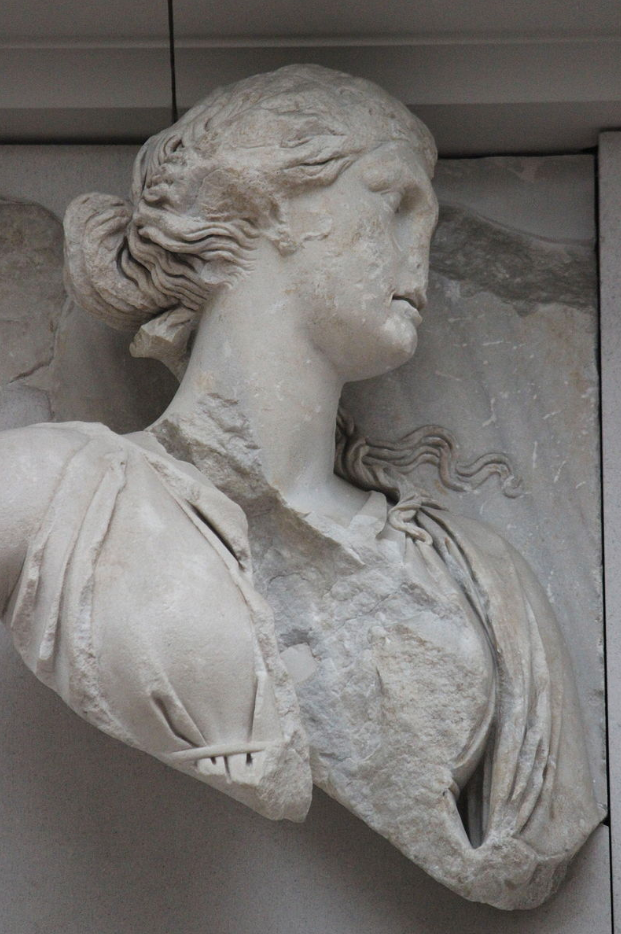
In the frieze of the Great Altar of Pergamon (Berlin),
the goddess who fights at Helios' back is conjectured to be Theia
As a side note, and this is my own conjecture, I can’t help but wonder if there isn't a close, if not exact, correlation between Theia and Theotokos. The latter is a combination of the Greek words Theos (god) and tokos (childbirth or one who gives birth). Thus, Theotokos literally means "the one who gave birth to God," or "the Mother of God." For this reason, it is the official title of the Virgin Mary in Orthodox Christianity.
The exact interpretation of this term in Orthodoxy has been a point of much contention, even leading to a schism in the Church. But I can't help but see the similarity between the mother of the sun and the mother of the Son of God.
There’s much to be said here about the esoteric meaning of the "virgin" birth and the birth of "Christ," but that's a topic for another essay altogether. What I will say is that my initial interest in the Theotokos began decades ago when I immersed myself in learning about Orthodox Iconography, an interest that culminated in my taking an intensive workshop in which I learned how to “write” an icon myself.
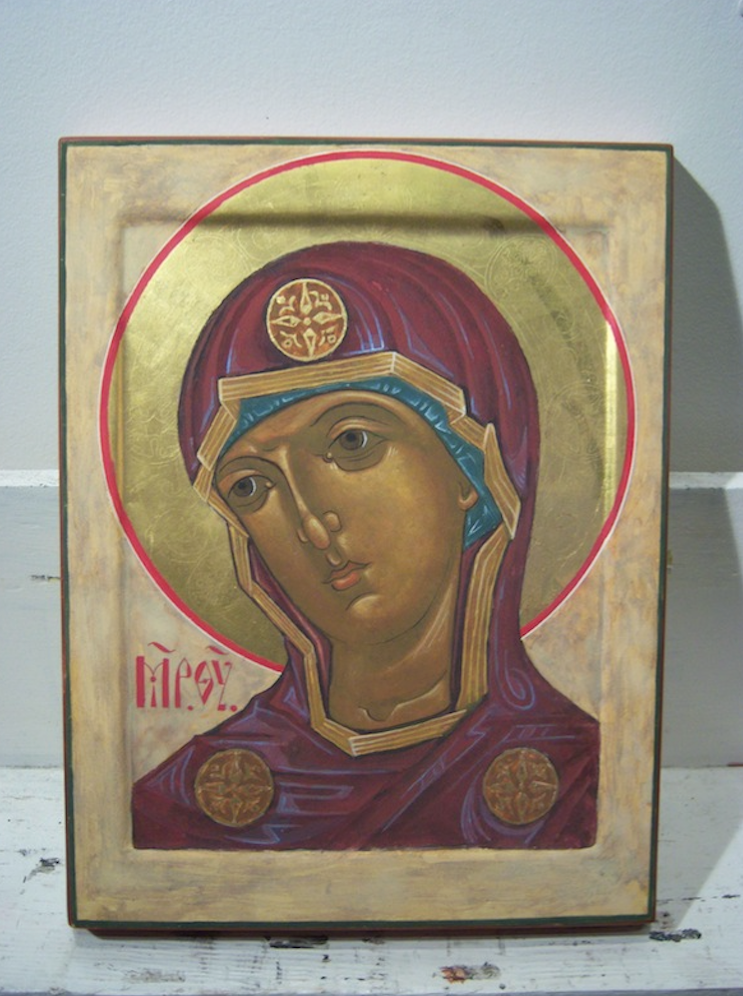
My first Icon, taught to me by
the Prosopon School of Iconogrpahy
Meaning from the Void
An icon is meant to be a window unto Heaven, and the first step in creating one is contemplating nothingness. As the blank panel sits empty and ready to accept anything, we ask ourselves, "What do I understand of Nothing?"
As a secular artist, I can’t help but see a parallel and view the blank canvas as a primordial void, the role of the artist being a microcosmic act of creation, bringing order and meaning into being. The act of painting is an act of revelation of the artist’s soul and, in a sense, is the living, breathing manifestation of a spiritual truth.
But this isn't something relegated only to those of us who consider ourselves “artists.” I believe that we are all called to be the creators of our world, to be the architects, to have agency, and to reveal our soul through our own individual means, whether that be in our work, prayer, meditation, hobbies and play, or family and relationships. For some, this revelation might even come by way of resonating and falling in love with works of art, paintings that, for a lack of better words, simply resonate. I can’t help but think this is the viewer's soul recognizing a bit of itself in a work of art, that work being a mirror.
I’ll end with this final thought: while the gods and goddesses of the Greeks might seem like myths a million miles from our modern world, maybe, just maybe, they represent spiritual truths that transcend time and can find meaning in our daily lives if we just take the time to listen.
Little did I know that the title, Thea, had most likely been assigned to the painting well before I applied the first brushstrokes, with the muses gently whispering it in my mind all along.
You can learn more about Thea
HERE
TRADE SECRET


